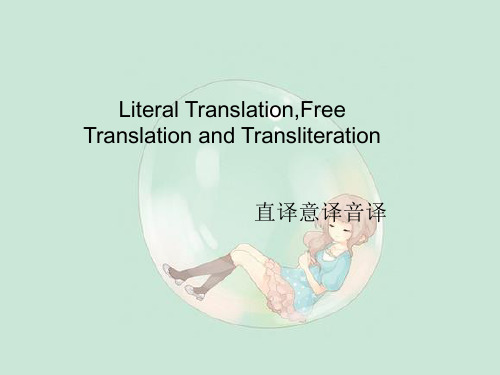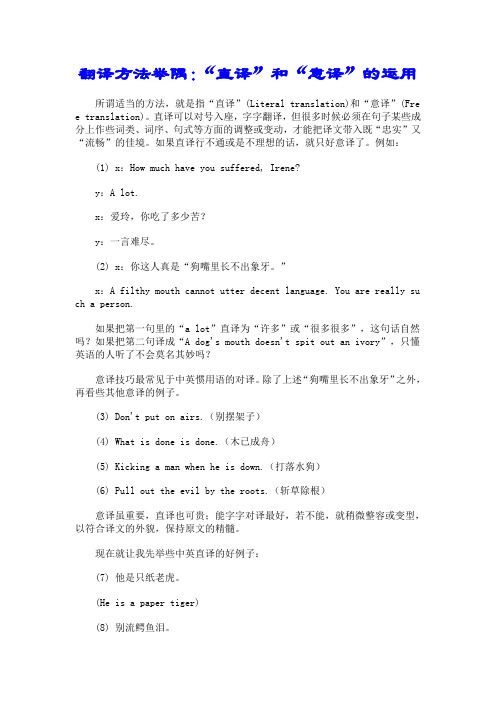英语翻译 汉译英4词语的直译和意译
汉译英 成语的翻译

Strike while the iron is hot. 趁热打铁。 Walls have ears. 隔墙有耳。 Constant dropping wears the stone. 水滴石穿。 Actions speak louder than words.
事实胜于雄辩。
成语翻译要注意的事项
汉语成语的语言特色,即形象鲜明、常用典故、
音韵和谐,翻译时应尽可能地保留这些特色。 然而由于汉英两种语言和文化的巨大差异,汉 语成语的这些特色很难全部在译文中得以再现, 此时译者必须有所舍弃,采取适当的翻译策略 以确保主要信息的传递。 现代翻译学认为,译文与原文在意义上应动态 对应,不要形式对等。因此,从原文的深层意 义出发,汉语句子当中的四字词组在译成英语 时都有可能与英语句中的单词、短语、习语甚 至整句相对应。
Don’t count your chickens before they are hatched. 不可过早乐观。 Every cloud has a silver lining. 天下没有绝对的坏事。 Among so many well-dressed and cultured people, the country girl felt like a fish out of water. 同这么多穿着体面而又有教养的人在一起,这位乡下 姑娘感到很不自在。 She was born with a silver spoon in her mouth; she thinks she can do what she likes. 她生长在富贵之家,认为凡事都可随心所欲。
TRANSLATION APPRECIATION
1.It is too late to grieve when the chance is past. 坐失良机,后悔已迟。 2.It’s never too late to learn. 活到老,学到老。 3.Joy at its height engenders sorrow. 乐极生悲。 4.Justice has long arms.
英语翻译--汉译英4.词语的直译和意译

香酥鸡 清炖甲鱼 鱼香肉丝 涮羊肉 青椒肉片 五香牛肉 红烧狮子头 麻婆豆腐 炸酱面 元宵 童子鸡 四喜丸子
crisp fried chicken braised turtle in clear soup fish-flavored shredded pork in hot sauce instant boiled mutton fried sliced pork and green pepper spiced beef stewed minced pork balls with brown sauce spicy bean curd in Sichuan style noodles in Beijing style sweet dumpling spring chicken braised pork balls in gravy
most-favored-nation treatment
2. 词语的意译
拳头产品
competitive products / knock-out products
经济作物
cash crops / industrial crops
向钱看
money-oriented / money grubbing / money mad
专业技术职务
(副)教授 讲师 助教 (副)研究员 助理研究员 (副)编审 (助理)编辑 主任医师 主治医生 高级经济师 高级会计师
( associate) professor lecturer assistant teacher ( associate) research fellow assistant research fellow ( associate) professor of editorship ( assistant) editor professor of medicine consultant senior business engineer senior accountant
翻译方法--直译和意译

意译决不是妄加删改,添油加醋的胡译,乱译. 1.It rains cats and dogs. 雨下得很大. 2.我就是跳进黄河也洗不清. It can't make me clean even if I jump into the Yellow River. Nothing could bring back my innocence. 3.Criminals must be made to see the consequences of their crimes. "An eye for eye and a tooth for tooth " is the very basis of Justice. 直译:必须使罪犯看到自己犯罪的结果,"以眼还眼, 以牙还牙"正是法制的基础. 意译:必须使罪犯看到自己犯罪的结果,"以其人之道 还治其人之身"正是法制的基础.
我走在厚厚的地毯上,一点脚步声也没有.
3. You should not despise him because 看不起他. 4. Reports of new successes keep pouring in. 捷报频传 5. He sold hard-to-get items. 他兜售紧俏商品.
1. 你越是努力学习英语,你说英语就会越好. The harder you study English, the better you speak it. 2. 据说他一直学英语. He is said to have been studying English./ It is said that he has been studying English. 3. 他要在美国学习的愿望是可以理解的. His wish to study in America is quite understandable./ It is quite understandable that he wishes to study in America.
全国大学英语四级翻译 CET4 四级翻译新题型技巧讲解

长嗟短叹 -- sighing deeply 发号施令-- issue orders 土崩瓦解-- fall apart 两面三刀-- two-faced tactics
3. 词类转换
词类变形和转换,是英语语言的一个很重要的特 点,尤其是名词、动词、形容词这三种最主要的 词类。
译直)译与意译相互关联,互为补充,两种译法可以并用
二、 汉译英的基本技巧
1. 增词 为了充分传达原文含义,必须增补词语,以求达意.
北京是中国的政治、文化中心。这里你可以游览万 里长城、故宫、颐和园等。
Beijing is a political and cultural center that offers some scenic attractions: the Great Wall, the Forbidden City, the Summer Palace etc.
Practice Please.
省名词
见到自己的故乡,他想起了童年的情景。
The sight of his native place called back his
childhood.
(省动词)
他连续讲了两小时的法语,没有出现任何错误。 He has been speaking in French for two hours
汉译英的 基本技巧
一、翻译的基本方法: 直译 & 意译
直译:保持原文内容、又保持原文形式,基 本保留原有句子结构,不是死译。
意译:只保持原文内容、不保持原文形式, 更多考虑英语的特点。
如: 我们的朋友遍天下。 Our friends are all over the world. (直译) We have friends all over the world.(意
直译和意译-英语翻译相关

胆小如鼠
一箭之遥
湿如落汤鸡
蠢得像猪 犟得像牛 缘木求鱼 守口如瓶
• • • • • • • • • • • • •
lead a dog‘s life 过着牛马一样的生活 cry up wine and sell vinegar 挂羊头,卖狗肉 put back the clock 开倒车 talk horse 吹牛 kill the goose that lays the golden eggs 杀鸡取卵 drink like a fish 牛饮 Once the wife of a parson, always the wife of a parson. • 嫁鸡随鸡,嫁狗随狗。
• 3)When should we depend on 直译法 ? • (1) Common civilization core, 某些习语和短 • • • • • • •
语的翻译 ,例如: cold war 冷战 hot line 热线 hot girls in cool suit, spicy girl 辣妹 Hot-selling books 热销书/畅销书 black market 黑市 pillar industry 支柱产业 Blood is thicker than water. 血浓于水
• 二、意译法 free translation
• 1)意译(归化法)指只忠实原文内容,不拘泥原文结
构形式与修辞手法的翻译方法。信息的传递为第一位。
• 第一位忠于原文内容 • 第二位通顺的译文形式要求在保持原文内容的前提下,
力求使译文在选词用字、句法结构、形象比喻及风格 特征等方面尽可能符合译语读者的阅读习惯和审美心 理。通用、联用、惯用 • 第三位忠于原文形式 • John can be relied on. He eats no fish and plays the game. • 约翰为人可靠,他既忠诚又正直。
浅谈英语翻译中的直译和意译资料讲解

浅谈英语翻译中的直译和意译浅谈英语翻译中的直译和意译一)、Literal translation 直译(异化法 foreignization )Free translation 意译(归化法 domestication)英、汉两种语言在结构和语义表达方面存在着雷同和差异,翻译时有时用直译,有时用意译。
(1)、直译(Literal translation)指不仅忠实于原文内容,而且忠实于原文形式的翻译方法.直译把忠于原文内容放在第一位,把忠于原文形式放在第二位,要求在保持原文内容的前提下,力求使译文与原文在选词用字、句法结构、形象比喻及风格特征等方面尽可能趋同(无限接近)。
直译把通顺的译文形式放在第三位。
(1.1)直译的应用:(1.1.1)某些习语和短语的翻译,例如cold war 冷战 hot line 热线 spicy girl 辣妹black market 黑市 paper tiger纸老虎Blood is thicker than water 血浓于水The heart is seen in wine. 酒后吐真言(1.1.2)含义广为流传,读者较为熟悉的短语、习语等, 直译可以丰富译语语言。
例如:A. He walked at the head of the funeral procession, and every nowand then wiped his crocodile tears with a big handkerchief.他走在送葬队伍的前头,还不时用一条大手绢抹去那鳄鱼的眼泪。
B. The Senate Foreign Relations Committee today extended the olivebranch to the Clinton Government by pleading for cooperation indeveloping foreign policy.参议院外交委员会今天向克林顿政府伸出了橄榄枝,要求在发展外交政策上合作。
直译意译和音译完整版

直译
With seven mouths and eight tongues To have sb. by the throat A soft bone
意译
All talking at once; Everybody being eager to put in a word To give sb. tremendous trouble; to strangle A spineless man
直译的局限性 东西方在文化背景和语言结构方面有许多差异。差 异太大时,用直译法翻译是不能被译入国读者所接受的。 翻译界有个老笑话:在一个宴会上,外宾对主人 说:“你的夫人很漂亮。”主人回答:“哪里,哪里。”译 者翻译成“where, where?”“不见得,不见得,”主人再 次客气地回答道。译员翻译说:“You can’t see, you can’t see.” 这样的直译忠实原文吗?如果用意译,就能够把正确 的信息传递给双方。“哪里哪里”应意译为“I’m flattered,”“不见得”应译为“I don’t think so.” 有经验的译员会增加释译:“Chinese are usually modest.”让外国人知道“I don’t think so”只是中国 人谦虚的表示,而不是对客人看法的否定
• • • • • • • 人名: Abraham 亚伯拉罕 Blair 布莱尔 McDonald 麦克唐纳 Stevenson 史蒂文森 Elizabeth 伊丽莎白 Shakespeare莎士比亚
• • • • • •
地名: Edinburgh 爱丁堡 Coventry 考文垂 Cincinnati 辛辛那提 New York 纽约 Los Angeles洛杉矶
(二)约定俗成原则 有些译名的发音明显有误,但通行已久, 约定俗成,所以即使不符合音译标准,也不 必改了。 如Eden音为/i:dn/ (伊登),但习惯译为 “艾登”。Bethune统一译成“贝休恩”, 但加拿大Norman Berthune译名为“白求 恩”;Marx一般译成“马克斯”,但Karl Marx译成“马克思”。 Bernard Shaw译 成“肖伯纳”等。
翻译方法举隅:“直译”和“意译”的运用

翻译方法举隅:“直译”和“意译”的运用所谓适当的方法,就是指“直译”(Literal translation)和“意译”(Fre e translation)。
直译可以对号入座,字字翻译,但很多时候必须在句子某些成分上作些词类、词序、句式等方面的调整或变动,才能把译文带入既“忠实”又“流畅”的佳境。
如果直译行不通或是不理想的话,就只好意译了。
例如:(1) x:How much have you suffered, Irene?y:A lot.x:爱玲,你吃了多少苦?y:一言难尽。
(2) x:你这人真是“狗嘴里长不出象牙。
”x:A filthy mouth cannot utter decent language. You are really su ch a person.如果把第一句里的“a lot”直译为“许多”或“很多很多”,这句话自然吗?如果把第二句译成“A dog's mouth doesn't spit out an ivory”,只懂英语的人听了不会莫名其妙吗?意译技巧最常见于中英惯用语的对译。
除了上述“狗嘴里长不出象牙”之外,再看些其他意译的例子。
(3) Don't put on airs.(别摆架子)(4) What is done is done.(木已成舟)(5) Kicking a man when he is down.(打落水狗)(6) Pull out the evil by the roots.(斩草除根)意译虽重要,直译也可贵;能字字对译最好,若不能,就稍微整容或变型,以符合译文的外貌,保持原文的精髓。
现在就让我先举些中英直译的好例子:(7) 他是只纸老虎。
(He is a paper tiger)(8) 别流鳄鱼泪。
(Don't shed crocodile tears)(9) 应该弥补代沟。
(We must bridge the generation gap)(10) 这事使他丢脸。
